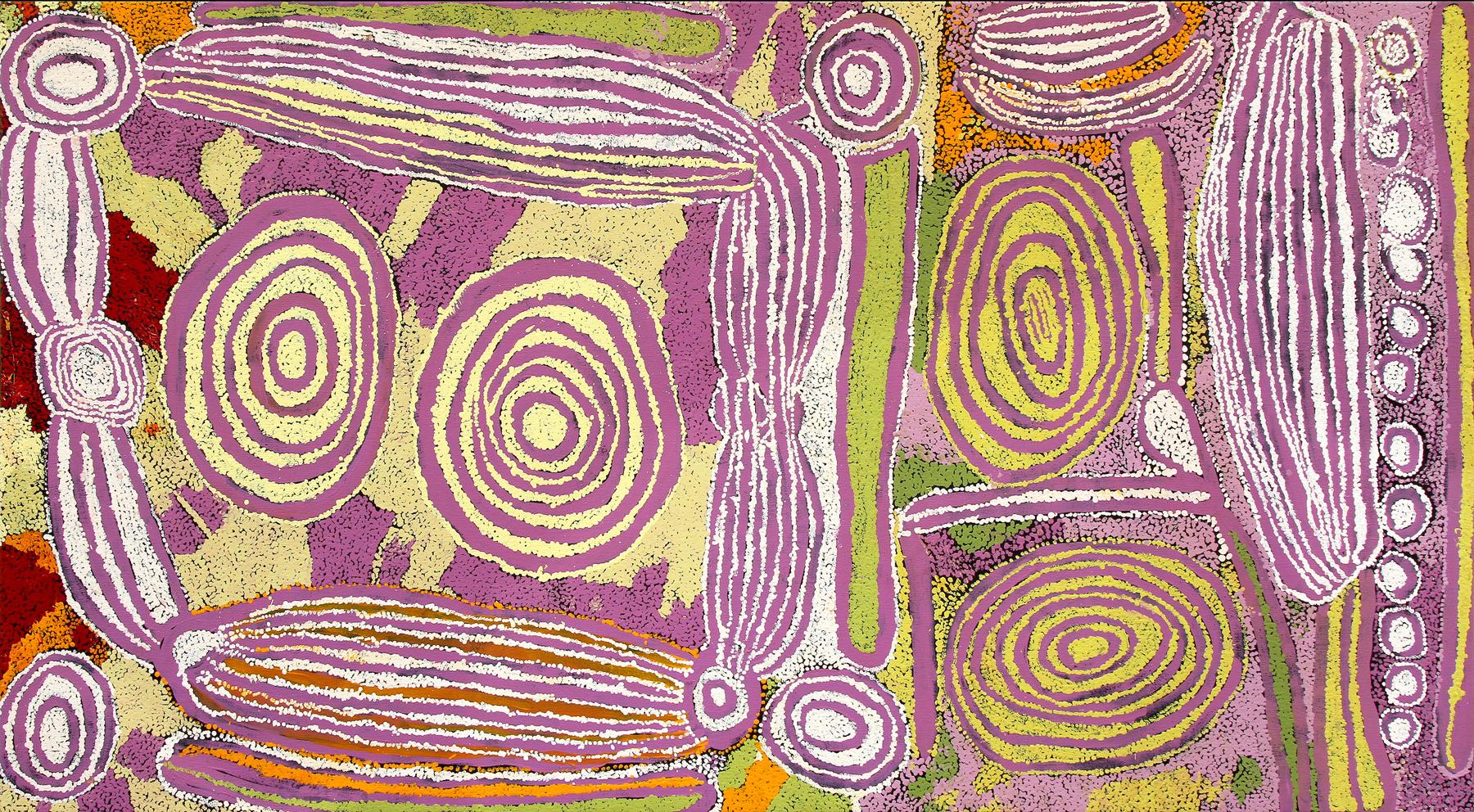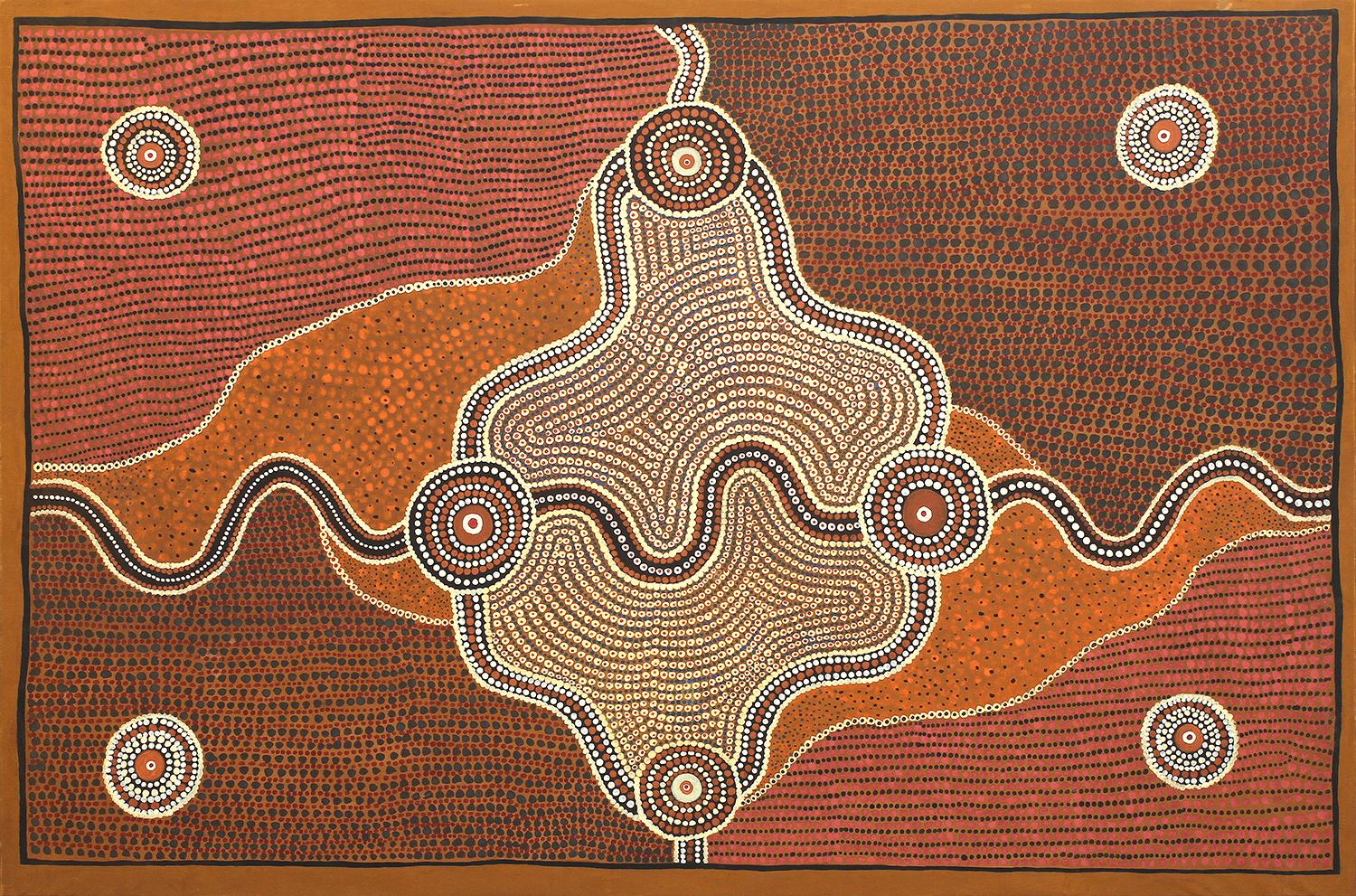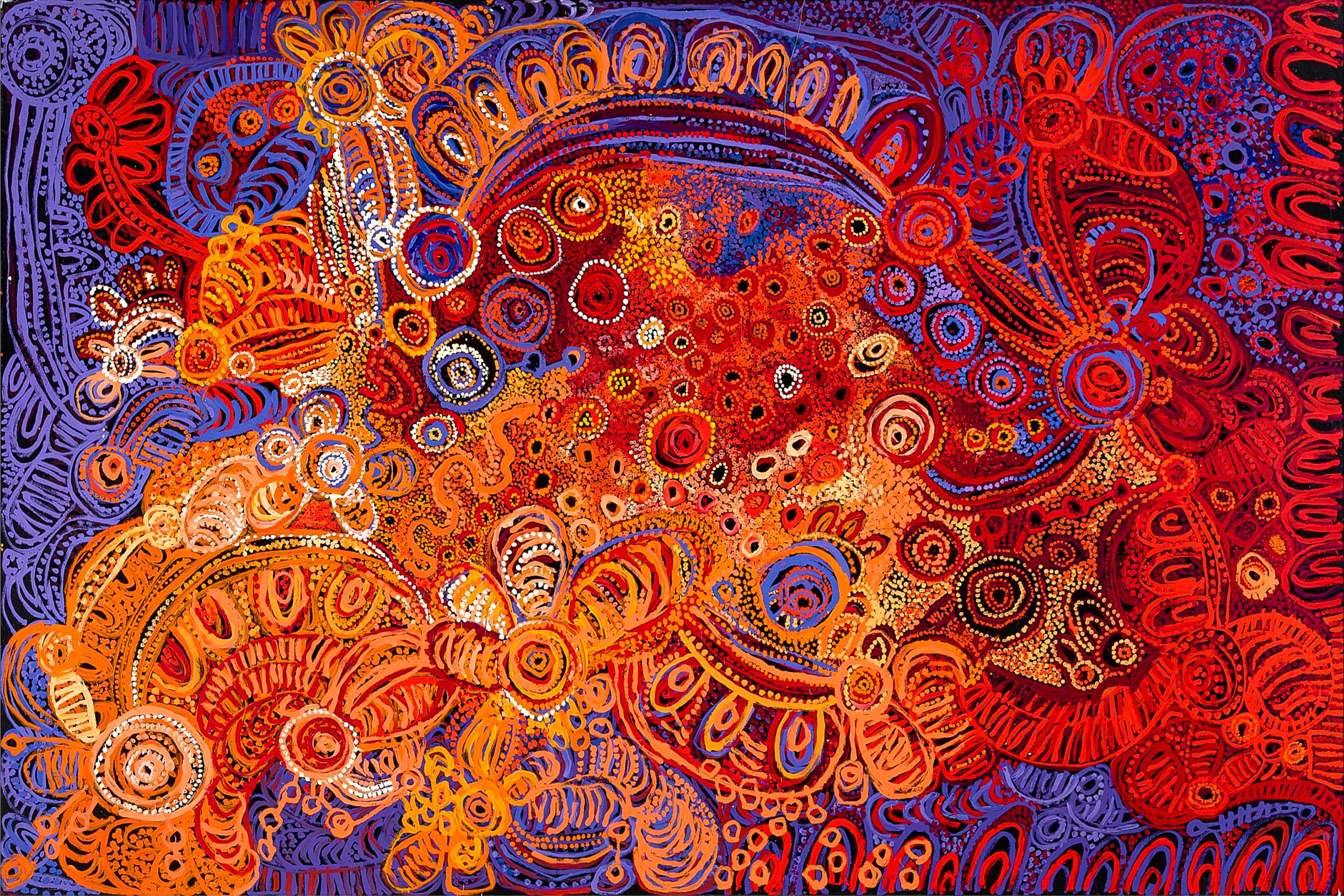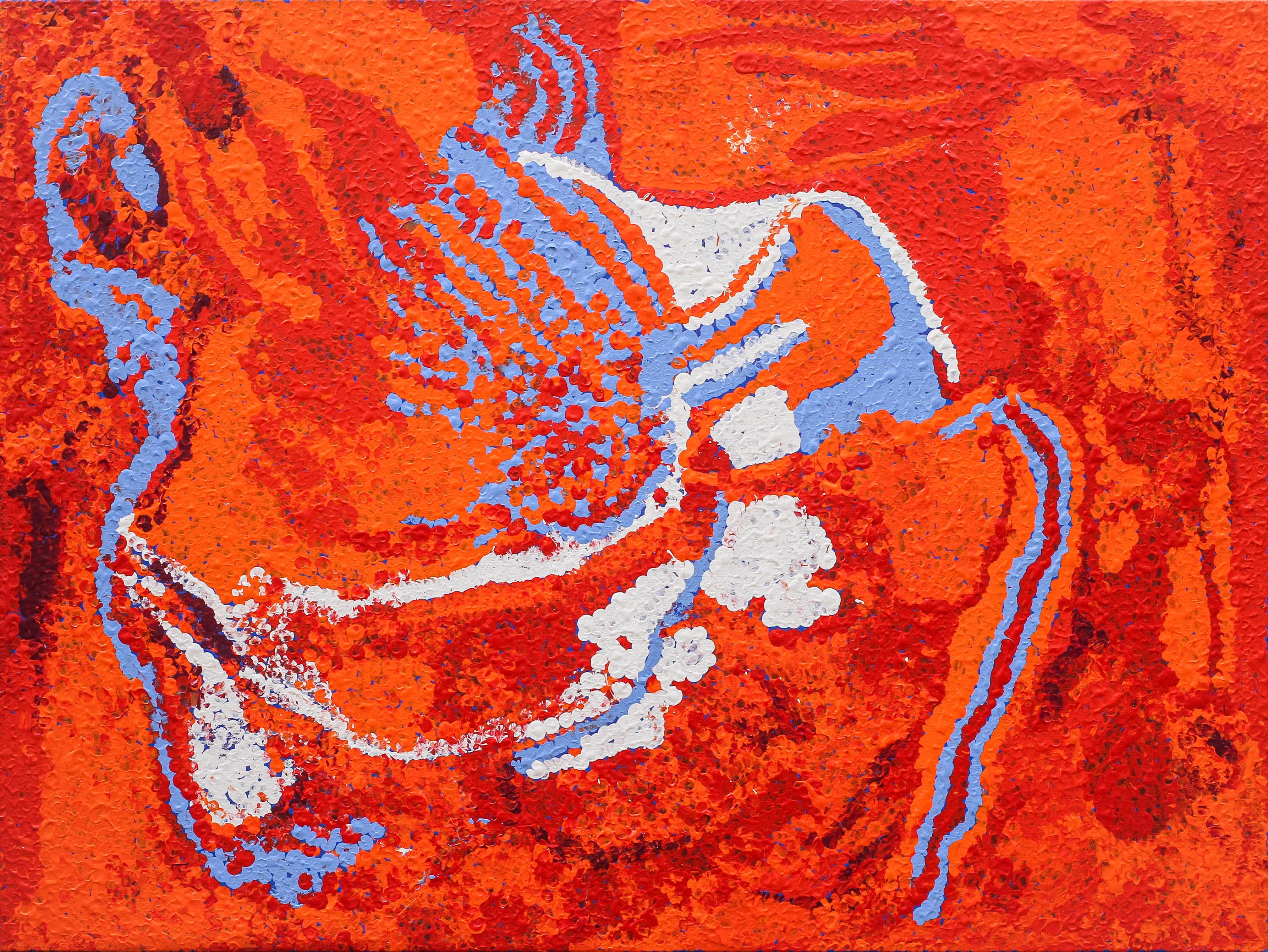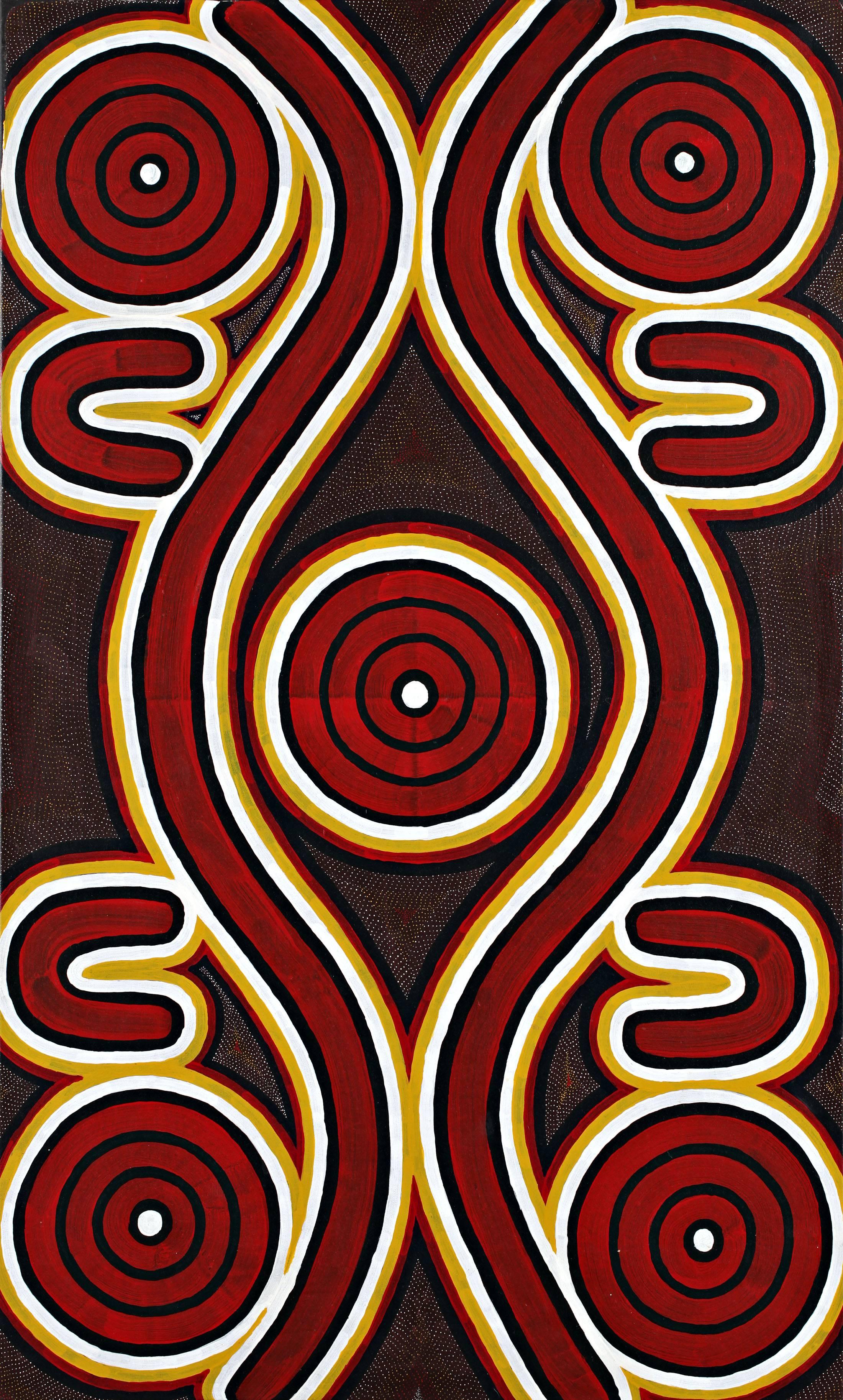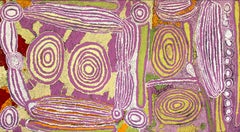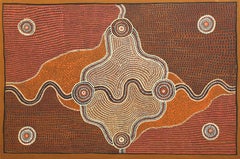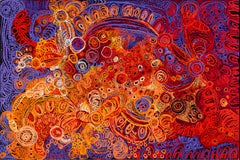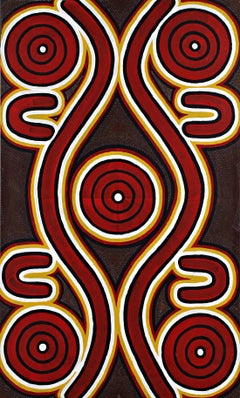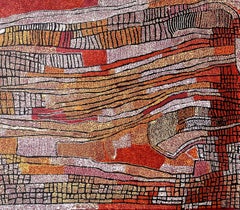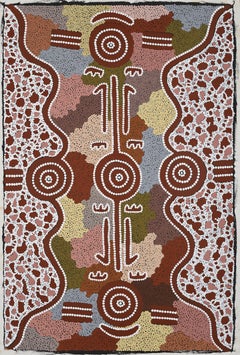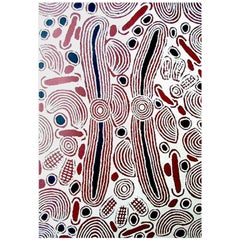Items Similar to Turkey Tolson - "Two Women Travelling at Puja" - 182x182cm 2006 - Aboriginal Art
Want more images or videos?
Request additional images or videos from the seller
1 of 2
Turkey Tolson Tjupurrula Turkey Tolson - "Two Women Travelling at Puja" - 182x182cm 2006 - Aboriginal Art1986
1986
$170,000
£127,909.20
€147,737.84
CA$240,254.37
A$260,712.62
CHF 138,154.72
MX$3,197,513.34
NOK 1,709,654.64
SEK 1,615,533.12
DKK 1,102,936.71
About the Item
Turkey Tolson Tjupurrula (c.1938-2001)
« Two Women Travelling At Puja »
182×182 cm – 1986
Provenance: From Papunya Tula Artists, certificated
Sotheby’s, Melbourne, 1996,
Corporate Collection, Melbourne
Christies, Melbourne, Australian Aboriginal Art, 2005
Aboriginal Art
Turkey Tolson Tjupurrula
(c. 1938 – 2001)
Aboriginal Australian Artist Pintupi Elder Papunya Tula Pioneer
Turkey Tolson Tjupurrula was born around 1938 near Haasts Bluff, in the Northern Territory of Australia. He was a member of the Pintupi people, one of the Western Desert groups with deep connections to the land, language, and Tjukurrpa (Dreaming).
He grew up living a traditional, semi-nomadic lifestyle before being relocated—along with many other Pintupi people—to the government-established settlement of Papunya in the early 1960s.
Career
In 1972, Turkey Tolson became one of the founding artists of the Papunya Tula Artists cooperative, a pivotal moment in the development of contemporary Aboriginal art. This movement marked the first time Aboriginal men began painting their cultural stories using Western materials like acrylics on canvas and board.
His paintings often depict Dreaming stories (Tjukurrpa) passed down through generations, using a visual language of concentric circles, parallel lines, dots, and geometric shapes. His subjects included ceremonial events, sacred sites, and ancestral journeys, especially those associated with spear-making and men’s business.
Style and Legacy
Tjupurrula’s style evolved over the years from dense dotting to bold, minimalist compositions. One of his most iconic works is:
"Straightening Spears at Ilyingaungau" (1987) – a striking painting that uses minimal lines to represent a ceremonial act involving the making of spears.
His work is celebrated for balancing spiritual depth with visual simplicity, making it accessible to a global audience while retaining sacred cultural meaning.
Recognition and Collections
Turkey Tolson’s works have been exhibited nationally and internationally, and they are included in prestigious collections such as:
National Gallery of Australia
Art Gallery of New South Wales
Art Gallery of South Australia
International galleries and museums in Europe and the U.S.
Beyond his art, Tjupurrula was a respected elder and cultural custodian. He played an important role in mentoring younger artists and preserving Pintupi traditions through storytelling and ceremony. He helped revive and maintain ties to traditional lands, particularly during the return to outstations (homelands) movement.
Turkey Tolson Tjupurrula passed away in 2001. He is remembered as a key figure in both Australian contemporary art and Indigenous cultural renewal. His work continues to inspire and educate new generations about the depth and beauty of Western Desert culture.
Collection: Art Gallery of New South Wales
Art Gallery of South Australia
National Gallery of Australia
National Gallery of Victoria
National Museum of Australia
Art Gallery of Western Australia
Quennsland Art Gallery
Artbank, Alice Springs Law Court
Flinders University Art Museum
(Berndt Museum of Anthropology), Perth, WA
Robert Holmes a Court Collection, Perth, WA
Darwin Supreme Court
Ebes Collection
Donald Kahn Collection (USA)
Richard Kelton Foundation Collection
(USA)…
- Creator:Turkey Tolson Tjupurrula (1938 - 2001, Aboriginal Australian)
- Creation Year:1986
- Dimensions:Height: 71.66 in (182 cm)Width: 71.66 in (182 cm)Depth: 1.58 in (4 cm)
- Medium:
- Movement & Style:
- Period:
- Condition:Minor restoration but in excellent condition for 1986.
- Gallery Location:PARIS, FR
- Reference Number:1stDibs: LU2847216341872
About the Seller
No Reviews Yet
Vetted Professional Seller
Every seller passes strict standards for authenticity and reliability
1stDibs seller since 2025
- ShippingRetrieving quote...Shipping from: PARIS, France
- Return Policy
Authenticity Guarantee
In the unlikely event there’s an issue with an item’s authenticity, contact us within 1 year for a full refund. DetailsMoney-Back Guarantee
If your item is not as described, is damaged in transit, or does not arrive, contact us within 7 days for a full refund. Details24-Hour Cancellation
You have a 24-hour grace period in which to reconsider your purchase, with no questions asked.Vetted Professional Sellers
Our world-class sellers must adhere to strict standards for service and quality, maintaining the integrity of our listings.Price-Match Guarantee
If you find that a seller listed the same item for a lower price elsewhere, we’ll match it.Trusted Global Delivery
Our best-in-class carrier network provides specialized shipping options worldwide, including custom delivery.More From This Seller
View AllWingu Tingima "Kungkarrakalpa" 110x203cm - 2006 Aboriginal art
Located in PARIS, FR
Wingu Tingima (c.1920–2010)
"Kungkarrakalpa"
110x203cm - 2006
Acrylic on linen
Aboriginal art
Provenance:
Certificate of authenticity from arts centre
Biography
Wingu Tingima ...
Category
Early 2000s Abstract Abstract Paintings
Materials
Acrylic
Wenten Rubuntja "Emu Dreaming" Aboriginal Painting 182x275 cm Aboriginal Art
Located in PARIS, FR
Wenten Rubuntja (1926-2005)
Title "Emu Dreaming
Aboriginal Painting
Size: 182x275cm
year: 1987
Acrylic and Pigments on canvas
inscribed verso with Avant Galleries cat. no. 242
...
Category
20th Century Abstract Abstract Paintings
Materials
Acrylic, Pigment
Rhoda Tjitayi "Piltati Tjukurpa" 200x300cm - 2021 - Aboriginal Art
Located in PARIS, FR
Artist: RHODA TJITAYI, (1969 -),
Titre: Piltati Tjukurpa
200x300 cm - 2021
Acrylique on canvas
réf:15021AS
Biography:
Rhoda Tjitayi’s monumental paintings reflect the richness of...
Category
21st Century and Contemporary Contemporary Abstract Paintings
Materials
Acrylic
Rhoda Tjitayi "Piltati Tjukurpa" 200x300cm - 2021 - Aboriginal Art
Located in PARIS, FR
Artist: RHODA TJITAYI, (1969 -),
Titre: Piltati Tjukurpa
200x300 cm - 2021
Acrylique on canvas
From Art Centre
réf:15021AS
Aboriginal Art
Biography:
Rhoda Tjitayi’s monumental p...
Category
21st Century and Contemporary Contemporary Abstract Paintings
Materials
Acrylic
Yannima Tommy Watson "Ngayuku Ngura" - 91x122 cm -2013 - Aboriginal Art
By Yannima Tommy Watson
Located in PARIS, FR
Artist: Tommy Watson Yannima Pikarli (c.1935-2017)
size: 91x122cm
year: 2013
Acrylic on linen
Aboriginal Art
Provenance:
Yanda Art, Australia (certificat)
Aborigène Galerie Paris,...
Category
2010s Contemporary Abstract Paintings
Materials
Acrylic
Ronnie Tjampitjinpa "Body paint designs" 121x153 cm - 1996 - Aboriginal Art
By Ronnie Tjampitjinpa
Located in PARIS, FR
Ronnie Tjampitjinpa (c.1943-2023)
Size: 121x153 cm
Year: 1996
Acrylic on canvas linen
Aboriginal Art
Provenance: Papunya Tula Artists
Ronnie Tjampitjinpa was born around 1943 at Tji...
Category
Late 20th Century Contemporary Paintings
Materials
Acrylic
You May Also Like
Sandy Hunter Petyarre, "Men's Dreaming" Aboriginal Art Painting
By Sandy Hunter Petyarre
Located in Collonge Bellerive, Geneve, CH
Sandy Hunter Petyarre painting "Men's Dreaming,"
1996.
Dimensions: 125 x 75 cm.
Group Anmatyerre - Utopia - Central Desert.
Sandy Hunter Petyarre was born in 1953. She is one o...
Category
1990s Abstract Paintings
Large Stunning Australian Aboriginal Painting by Naata Nungurrayi
By Naata Nungurrayi
Located in Atlanta, GA
A large and stunning contemporary abstract painting by celebrated Australian Aboriginal artist Naata Nungurrayi (1932-2021), stretched and ready for display. A rare masterpiece of the museum quality dating from the peak of the artist's creative output in 2003. The canvas is singular in both the impressive size and tine quality, and it comes with full provenance and step by step photos (100 in total) recording the creation of this significant piece of work.
The artist used fine dots as the sole element to compose a complex dreamtime landscape where Women's Ceremony took place in her ancestral time. The place is located at Marrapinti and its surrounds, where many water soakage holes were located. Dots in brilliant shifting and contrasting colors form ceremonial Tingari symbols performed by the women, black crawling tracks that may be associated with a site called Karilywarra (two carpet snakes) and mesmerizing Tali (sandhill) movements surrounding the canvas. The work is of the signature style of the artist, singular and easily recognizable. The fine quality of this work is exemplary.
Medium: acrylic on Belgium Linen
Cat no. NN200315
Provenance: Yanda Aboriginal Art, NT.
The painting comes with a COA letter and an artist biograph issued by Yanda Aboriginal Art and a presentation album with 100 photos that documented the entire process of the creation of this large work of art. The edge of the painting bears name of the artist as well as the stamp of the gallery as shown.
Reference and further reading:
For a relevant work by the artist, See Plate 88 and Page 220-222 in the book "Past and Present Together: Fifty Years of Papunya Tula Artists" by Meyers and Skerritt.
Another similar work is illustrated on plate 13 in "Pintupi" by Hamiltons.
Artist's biography:
Naata Nungurrayi (1932-2021) is an Australian Aboriginal artist who was born at the site of Kumil, west of the Pollock Hills in Western Australia. She is from the Pintupi group from Kintore, Northern Territory and is one of the senior elders of the Kintore women artist movement. Naata is the sister of George Tjungurrayi and Nancy Nungurrayi, and her son is Kenny Williams Tjampitjinpa...
Category
21st Century and Contemporary Australian Modern Paintings
Materials
Canvas
Aboriginal Painting by Michael Nelson Tjakamarra
By Michael Nelson Tjakamarra
Located in Miami, FL
Michael Nelson Tjakamarra (also cited as: Michael Nelson Jagamarra, or Jakamara) is a Senior Warlpiri Tribesman and an Elder of the Papunya Community in central Australia. Born c. 1949 at Pikilyi, Vaughan Springs west of Yuendumu in the Northern Territory, he grew up ‘in the bush’. His father was an important tribal elder and medicine man at Yuendumu. It was therefore automatic that he would grow up with the traditional values and knowledge that now influences his paintings.
Michael lived at Haasts Bluff until his parents took him to Yuendumu for European education at the mission school. He left school at thirteen, after initiation, and worked at buffalo shooting, driving trucks, droving cattle and in the army, before returning to Yuendumu and then to Papunya to settle in 1976. He worked for a time in the Government store and for the Council.
Michael learned to paint at Papunya by observing the senior men such as Billy Stockman and Old Mick Tjakamarra. Although he was tutored by his uncle, Jack Tjupurrula, Michael developed his own style and began painting earnestly from 1983.
Michael is known as master desert painter for his depiction of several Dreamings in one painting. For him the understanding of the Dreaming stories that go with his paintings is all important – without the stories his paintings would ‘mean nothing’ as far as he is concerned. His Dreamings include the Possum, Snake, Two Kangaroos, Rock Wallaby, Bush Banana, Honey Ant and Yam.
In 1984 Michael won the National Aboriginal Art Award with his painting ‘Three Dreamings’. His reputation as a painter rose rapidly after this. He exhibited his work in the 1986 Biennale of Sydney and featured in ‘The State of the Art’, a British art documentary. In 1987 Michael had been asked to paint a major work (27’long) to decorate the foyer of Sydney’s Opera House and he chose to paint his ‘Possum Dreaming’ story. A great highlight in Michael’s career was in 1988 when he was commissioned to design a 196 sq-metre mosaic in the main forecourt of Australia’s new Parliament House in Canberra. The work was based on his ‘Kangaroo and Emu’ dreaming. Michael was presented to Her Majesty, Queen Elizabeth 11...
Category
2010s Contemporary Abstract Paintings
Materials
Linen, Acrylic
Contemporary Painting by Australian Aboriginal Artist Ningura Napurrula
By Ningura Napurrula
Located in Atlanta, GA
A large aboriginal painting by Ningura Napurrula (1938-2013).
Title: "Rockhole Site of Wirrulnga"
Artists: Ningura Napurrula (Australian Aboriginal, c.1938-2013)
Birthplace: Watul...
Category
20th Century Australian Modern Contemporary Art
Materials
Canvas
Sandy Hunter Petyarre - Aboriginal Art Painting
By Sandy Hunter Petyarre
Located in Collonge Bellerive, Geneve, CH
Sandy Hunter Petyarre
1994
150 x 90 cm
Group Anmatyerre - Utopia - Central Desert
Sandy Hunter Petyarre was born in 1953. She is one of the few artists to continue painting w...
Category
Abstract Geometric Abstract Paintings
Lander River to Purtulu, Mount Theo VERY LARGE Colorful Aboriginal Painting 1997
Located in Rancho Santa Fe, CA
This powerful and vividly colored diptych by Malcolm Maloney Jagamarra (born 1955), a renowned Warlpiri artist, is an extraordinary example of contemporary Aboriginal art, drawing deeply from cultural knowledge, ancestral memory, and ecological stewardship. Depicting the sacred narrative of the creation of the Lander River system, the painting is both a visual masterpiece and a spiritual map, tracing a journey through geography, kinship, and Dreaming (Jukurrpa).
At first glance, the canvas pulsates with energy. Vortices of concentric circles in rich ochres, reds, yellows, and blues dominate the composition, pulling the viewer into the spiraling flow of the Dreaming. These forms are not merely decorative; they carry deep cultural meaning. The blue line that winds through the center of both canvases is a stylized yet surprisingly geographical depiction of the Lander River, representing its twisting path through central Australia, from the artist’s home country of Willowra to Purtulu (Mount Theo), his mother’s land.
Purtulu, meaning “backbone” in Warlpiri, forms not only a physical destination but a metaphorical axis that holds the painting together. This backbone is both personal and cosmic—representing the spine of the land, the structure of ancestral lore, and Jagamarra’s own familial inheritance. The work is grounded in the artist’s kinship obligations and responsibilities to country, with specific references to the roles of kirda (owners of the Dreaming) and kurdungulu (caretakers). In Warlpiri culture, this relational dynamic is foundational—it is the system by which land is cared for, stories are maintained, and ancestral laws are fulfilled.
The Dreaming Goannas, positioned at each end of the canvases, are key ancestral figures. Their presence not only signals the sacred nature of this journey but also reflects the traditional Warlpiri iconography—note the “U” shapes, which are used to denote seated ancestors. The goanna is a totemic being, and its hunting patterns and ecological relationships are mirrored in human behavior. To maintain the health of the land and support the goanna population, it is necessary to burn the country regularly. Jagamarra references this practice with depictions of spinifex grass and hunting grounds, connecting mythological beings with tangible ecological practices, and blurring the line between story and science, belief and land management.
The left canvas contains the Owl Dreaming, where an abstracted face of the owl can be discerned—haunting and watchful. The owl, a silent observer of the night, brings wisdom and a sense of foreboding. It is a powerful spirit presence in many Aboriginal traditions. Meanwhile, the right canvas turns to the Warna, or Snake Dreaming. The snake, winding and water-bound, is both creator and destroyer, and its movement echoes that of the river. The snake’s body, woven into a hypnotic spiral, is a symbolic representation of the waterways that give life and form to the central desert.
This artwork is more than a painting—it is a teaching. It encodes knowledge about ecology, fire management, kinship roles, and sacred geography. It is both autobiographical and communal, a map of memory and belonging. Created within the living traditions of Warlpiri law, it speaks to the inseparable relationship between people and land in Aboriginal worldviews. Malcolm Maloney Jagamarra’s work is a powerful expression of this connection—his hand guided not only by brush but by heritage, ceremony, and Dreaming.
Its journey from the Aboriginal Art Galleries of Australia in Melbourne to the Kelton Foundation in Santa Monica, and its exhibition at venues such as the Australian Consulate in Los Angeles and the Indigenous Wisdom and Healing Conference in Virginia Beach...
Category
1990s Abstract Abstract Paintings
Materials
Canvas, Linen, Acrylic Polymer
